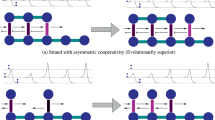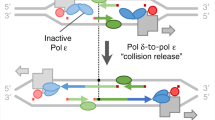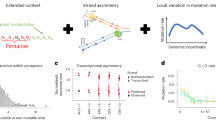Abstract
As the mechanisms for replicating the two strands of duplex DNA differ1 it is, in principle, possible for the mutation rates to differ depending on which strand is being copied. In the absence of selection this would lead to a difference in the measured rate of a particular base substitution, such as T to C, depending on which DNA strand was analysed to determine the rate. Thus a change such as T to C on one DNA strand results from either a direct T-to-C mutation on that strand or an A-to-G mutation on the complementary strand; for the other strand the situation is reversed, and it can be seen that different processes are responsible for the two cases, allowing for asymmetry in substitution rate. We have tested whether such asymmetry indeed occurs by studying equivalent sequences from the β-globin complexes of six species of primate. Our results reveal an asymmetry in substitution rates consistent with predictions based on strand-inequalities in mutation rates. Our sequence comparisons also allow us to make predictions about the positions of replication origins and the replication error rates of one strand relative to the other.
This is a preview of subscription content, access via your institution
Access options
Subscribe to this journal
Receive 51 print issues and online access
$199.00 per year
only $3.90 per issue
Buy this article
- Purchase on Springer Link
- Instant access to full article PDF
Prices may be subject to local taxes which are calculated during checkout
Similar content being viewed by others
References
1. Lewin, B. Genes (Wiley, New York, 1985). 2. Razin, A. & Riggs, A. D. Science 210, 604–610 (1980). 3. Koop, B. F., Goodman, M., Xu, P., Chan, K. & Slightom, J. L. Nature 319,234–238 (1986). 4. Maeda, N., Bliska, J. B. & Smithies, O. Proc. natn. Acad. Sci. U.S.A. 80, 5012–5016 (1983). 5. Maeda, N., Wu, C. I., Bliska, J. B. & Reneke, J. Molec. Biol. Evol (submitted). 6. Fitch, W. M. Syst. ZooL 20, 406–416 (1971). 7. Gojobori, T., Li, W. H. & Graur, D. / molec. Evol. 18, 360–369 (1982). 8. Lu, W. H., Wu, C. I. & Luo, C. C. /. molec. Evol. 21, 58–71 (1984). 9. Tajima, F. & Nei, M. /. molec. Evol 18, 115–120 (1982). 10. Topal, M. D. & Fresco, J. R. Nature 263, 285–293 (1976). 11. Fersht, A. R. & Knill–Jones, J. W. Proc. natn. Acad. Sci. U.S.A. 78, 4251–4255 (1981).
Author information
Authors and Affiliations
Rights and permissions
About this article
Cite this article
Wu, CI., Maeda, N. Inequality in mutation rates of the two strands of DNA. Nature 327, 169–170 (1987). https://doi.org/10.1038/327169a0
Received:
Accepted:
Issue Date:
DOI: https://doi.org/10.1038/327169a0
This article is cited by
-
Stem Region of tRNA Genes Favors Transition Substitution Towards Keto Bases in Bacteria
Journal of Molecular Evolution (2022)
-
Transcription-associated mutational asymmetry in mammalian evolution
Nature Genetics (2003)
-
Properties of a general model of DNA evolution under no-strand-bias conditions
Journal of Molecular Evolution (1995)
-
The influence of nearest neighbors on the rate and pattern of spontaneous point mutations
Journal of Molecular Evolution (1992)
-
DNA strand asymmetry
Nature (1991)
Comments
By submitting a comment you agree to abide by our Terms and Community Guidelines. If you find something abusive or that does not comply with our terms or guidelines please flag it as inappropriate.



